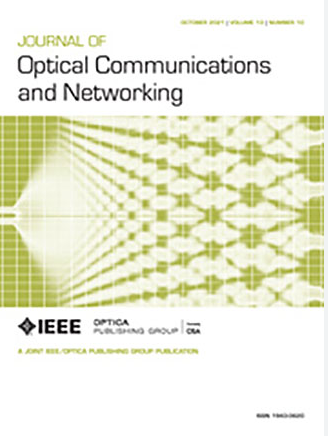未来相干城域+PON融合网络的可能架构分析与实验演示[特邀]
IF 4
2区 计算机科学
Q1 COMPUTER SCIENCE, HARDWARE & ARCHITECTURE
引用次数: 0
摘要
我们在本文中提出了一个详细的集思广益的未来选择合并城域和无源光网络(PON)接入网段,通过引入端到端相干传输实现。我们首先报告我们小组在OFC2024上的实验结果(本文是受邀扩展)。从这些初步但非常有希望的结果开始,我们详细阐述了两种不同的城域+PON收敛的可能原理图,在两个部分的边界使用边缘可重构光加丢复用器(roadm),然后我们通过实验表征和数值模拟的混合研究了它们的物理层可扩展性。我们的研究表明,相干收发器在这种情况下能够实现出色的性能,在穿越全光两个roadm时,每个波长至少允许200G,在大多数情况下甚至允许400G,然后路由到网络接入部分的高分割比PON。我们研究了几种现实条件,分析了不同的比特率、调制格式和网络架构,显示了能够使PON光分配网络损耗在29至35 dB范围内的物理层条件,符合当前国际标准的要求。可扩展性分析首先基于链路预算和光信噪比(OSNR)的基本限制,然后扩展到考虑其他物理层问题,例如roadm中的紧密光滤波。本文章由计算机程序翻译,如有差异,请以英文原文为准。
Analysis and experimental demonstration of possible architectures for future coherent metro+PON converged networks [Invited]
We present in this paper a detailed brainstorming on the future option of merging the metro and the passive optical network (PON) access network segments, enabled by the introduction of end-to-end coherent transmission. We begin by reporting the experimental results presented by our group at OFC2024 (for which this paper is an invited extension). Starting from these preliminary but very promising results, we elaborate on two different possible schematics for metro+PON convergence using edge reconfigurable optical add-drop multiplexers (ROADMs) at the boundary of the two segments, and then we study their physical layer scalability by a mix of experimental characterization and numerical modeling. We show that coherent transceivers enable excellent performance in this scenario, allowing at least 200G per wavelength and even 400G in most cases when traversing all-optically two ROADMs before being routed towards a high splitting ratio PON in the access part of the network. We study several realistic conditions analyzing different bit rates, modulation formats, and network architectures, showing the physical layer conditions that would enable the PON optical distribution network loss to be in the range from 29 to 35 dB, as required by current international standards. The scalability analysis is first based on link budget and optical signal-to-noise ratio (OSNR) fundamental limitations, and it is then extended considering other physical layer issues, such as tight optical filtering in the ROADMs.
求助全文
通过发布文献求助,成功后即可免费获取论文全文。
去求助
来源期刊
CiteScore
9.40
自引率
16.00%
发文量
104
审稿时长
4 months
期刊介绍:
The scope of the Journal includes advances in the state-of-the-art of optical networking science, technology, and engineering. Both theoretical contributions (including new techniques, concepts, analyses, and economic studies) and practical contributions (including optical networking experiments, prototypes, and new applications) are encouraged. Subareas of interest include the architecture and design of optical networks, optical network survivability and security, software-defined optical networking, elastic optical networks, data and control plane advances, network management related innovation, and optical access networks. Enabling technologies and their applications are suitable topics only if the results are shown to directly impact optical networking beyond simple point-to-point networks.

 求助内容:
求助内容: 应助结果提醒方式:
应助结果提醒方式:


